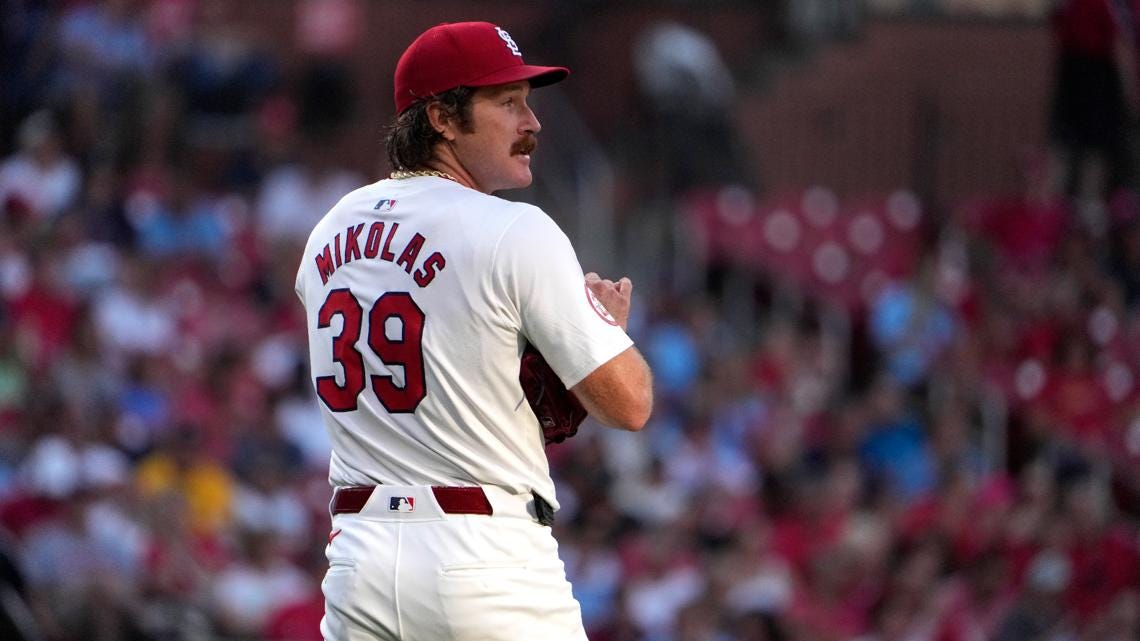Accepting Miles Mikolas for what he is
He isn't a bad starter. He's just not good in the traditional sense.
If you looked at Miles Mikolas’s ERA, you would be inclined to walk up to Bill DeWitt Jr.’s office right now and ask what that man is doing on his payroll.
Mikolas is good and bad strung together, stepping into the ugly zone on occasion during his starts. Years ago featured him as something more, when he was contending for a Cy Young award after showing back up from Korea. He overwhelmed St. Louis baseball fans with his 2018 season performance, where he finished sixth in Cy voting and played in the All Star Game.
The 2018-2022 Mikolas will be the best version that Cardinals fans see during his career. While he missed the 2020 and part of the 2021 season due to Tommy John surgery and recovery, the results were good over that five-year stretch. In 105 starts and 631 innings, Mikolas posted a very good 3.46/3.78 ERA-FIP split. He produced 9.3 wins above replacement (WAR) during that time period, and was someone the team could rely on for 65% of the year to be efficient.
That man went missing after the last playoff appearance for the Cardinals. Mikolas has made the starts and produced the innings since, but the results have been less than satisfying. In 67 starts and 373 innings over the last two seasons, he’s posted a 1.7 WAR and a rough 5.04/4.26 ERA-FIP split. He’s gone from a top of the rotation threat to someone who could be very good or very bad inside a road trip.
Mikolas doesn’t miss many bats and the hard-hit percentage can get nasty during the second and third time through the lineup. He was drilled for 226 hits in 2022 and 194 last season, and his average home runs allowed went from 0.7 in 2019 to nearly a homer and a half last season. The WHIP, aka average amount of hits and walks allowed per nine innings, has risen from 1.00 to 1.28. The last number won’t end the world, but it’ll eliminate all of your fingernails after a single start.
Via Baseball Savant, the only value the Cardinals saw came from Mikolas’s fastball, and his lack of walks is the only stat that stands out among his pitching stats on that website. He was average to poor in groundball percentage, hard-hit percentage, barrel percentage, fastball velocity, exit velocity, strikeout percentage, and heart attack origin percentage. If you kept looking, it just got worse. I’m not a stat geek like the stellar Bernie Miklasz, but you don’t need to be Columbo to understand Mikolas isn’t a healthy bet.
What does all of this mean? Mikolas isn’t getting any better, so fans will have to soak up the good things about his pitching. He will make 30 starts and produce 185-200 innings. He won’t walk a lot of people, because the ball doesn’t tend to stray too far from the hitter’s bats. Sooner or later, his offerings find lumber. He will give up a healthy amount of hard contact, hits, and some starts will require tequila instead of bourbon.
He won’t destroy your payroll to performance ratios, but you’ll be happy to see him go when his contract expires after the 2025 season. In the modern day market, spending $18.5 million on a starter isn’t exactly bad practice if there’s value. By today’s standards, though, Mikolas’s 2.0 WAR via Fangraphs doesn’t fulfill that value quota. They value 1.0 WAR at $8 million, so he’s a tad expensive. The 3.1 WAR in 2023 would be great, but don’t go chasing waterfalls.
At this point, Mikolas is who he is on the pitching mound: An innings machine who will get hit hard while flashing the occasional brilliance. You’ll wonder how he was that good that night then but so bad during others--and then it’ll dawn on you. He may look like Wyatt Earp, but he pitches like Jekyll and Hyde.
One more year, folks. At least he’s better than Steven “lottery winner” Matz.


